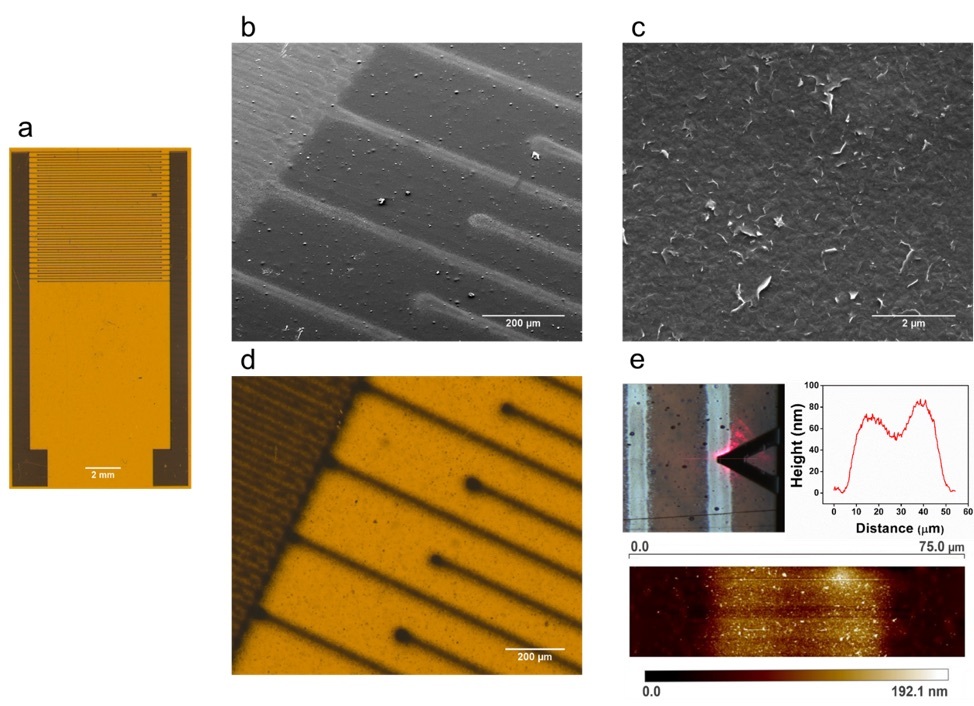Atomically thin sensors made with graphene can detect histamine, an indicator of spoiled fish and meat, down to 3.41 parts per million, researchers report.
The US Food and Drug Administration has set histamine guidelines of 50 parts per million in fish, making the sensors more than sensitive enough to track food freshness and safety.
The new sensors are made with graphene, a supermaterial that’s a carbon honeycomb just an atom thick. Graphene is known for its strength, electrical conductivity, flexibility, and biocompatibility.

The researchers produced the disposable food safety sensors with a low-cost, aerosol-jet-printing technology that’s precise enough to create the high-resolution electrodes necessary for electrochemical sensors to detect small molecules such as histamine.
“This fine resolution is important,” says Jonathan Claussen, an associate professor of mechanical engineering at Iowa State University and one of the leaders of the research project. “The closer we can print these electrode fingers, in general, the higher the sensitivity of these biosensors.”
The researchers’ paper describes how they aerosol jet printed the graphene electrodes on a flexible polymer and then converted them to histamine sensors by chemically binding histamine antibodies to the graphene. The antibodies specifically bind histamine molecules.
The histamine blocks electron transfer and increases electrical resistance, says Carmen Gomes, an associate professor of mechanical engineering at Iowa State. That change in resistance can be measured and recorded by the sensor.
“This histamine sensor is not only for fish,” Gomes says. “Bacteria in food produce histamine. So it can be a good indicator of the shelf life of food.”
The researchers believe the concept will work to detect other kinds of molecules, too.
“Beyond the histamine case study presented here, the (aerosol jet printing) and functionalization process can likely be generalized to a diverse range of sensing applications including environmental toxin detection, foodborne pathogen detection, wearable health monitoring, and health diagnostics,” they write in the paper.
For example, by switching the antibodies bonded to the printed sensors, they could detect Salmonella bacteria, or cancers or animal diseases such as avian influenza, the researchers wrote.
The researchers demonstrated broader application of the technology by modifying the aerosol-jet-printed sensors to detect cytokines, or markers of inflammation. The sensors, as reported in a recent paper published by ACS Applied Materials & Interfaces, can monitor immune system function in cattle and detect deadly and contagious paratuberculosis at early stages.
Claussen, who has been working with printed graphene for years, says the sensors have another characteristic that makes them very useful: They don’t cost a lot of money and can be scaled up for mass production.
“Any food sensor has to be really cheap,” Gomes says. “You have to test a lot of food samples and you can’t add a lot of cost.”
“This is a cheap, scalable, biosensor platform,” Claussen says.
The paper appears in the journal 2D Materials. Mark Hersam, a professor of materials science and engineering at Northwestern University, is coauthor.
Claussen is chief scientific officer and Gomes is chief research officer for NanoSpy Inc., a startup company based in the Iowa State University Research Park that sells biosensors to food processing companies. They say the company is in the process of licensing this new histamine and cytokine sensor technology.
The National Science Foundation, the US Department of Agriculture, the Air Force Research Laboratory, and the National Institute of Standards and Technology have supported the project.
Source: Iowa State University



